Spear

A spear is a pole weapon consisting of a shaft, usually of wood, with a sharpened head. The head may be simply the sharpened end of the shaft itself, as is the case with bamboo spears, or it may be of another material fastened to the shaft, such as obsidian, iron, or bronze. The most common design is of a metal spearhead, shaped like a triangle or a leaf.
Contents
|
Origins
Spear manufacture and use is also practised by the Pan troglodytes verus subspecies of the Common Chimpanzee. Chimpanzees near Kédougou, Senegal were observed to create spears by breaking straight limbs off trees, stripping them of their bark and side branches, and sharpening one end with their teeth. They then used the weapons to hunt galagos sleeping in hollows.[1] Orangutans also have used spears to fish, presumably after observing humans fishing in a similar manner.[2]
Prehistory
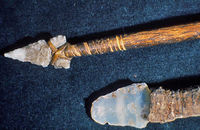
Archeological evidence found in Germany documents that wooden spears were used for hunting since at least 400,000 years ago.[3] Wood does not preserve well, however, and Craig Stanford, a primatologist and professor of anthropology at the University of Southern California, has suggested that the discovery of spear use by chimpanzees probably means that early humans used wooden spears as well, perhaps, five million years ago.[4]
Neanderthals were constructing stone spear heads from as early as 300,000 BP. By 250,000 years ago wooden spears were made with fire-hardened points. From 200,000 BP Middle Paleolithic humans began to make complex stone blades which were used as spear heads. At these times, a clear difference remained between spears designed to be thrown and those designed to be used in hand to hand combat. By the Magdalenian period (c. 15000-9500 BCE), spear-throwers similar to the later atlatl were in use[5]
The Fighting Spear
Spears were one of the most common personal weapons from the Stone Age until the advent of firearms. They may be seen as the ancestor of such weapons as the lance, the halberd, the naginata, the bill, and the pike. One of the earliest weapons fashioned by human beings and their ancestors, a spear still is used for hunting and fishing, and its influences still may be seen in contemporary military arsenals as the rifle-mounted bayonet.
Spears may be used as both ballistic and melee weapons. Spears used primarily for thrusting may be used with either one or two hands and tend to have heavier and sturdier designs than those intended exclusively for throwing. Those designed for throwing, often referred to as javelins, tend to be lighter and have a more streamlined head, and they may be thrown either by hand or with the assistance of a spear thrower such as the atalatl or woomera. Out of the atlatl dart, eventually the arrow for use with bows developed.
Ancient history
Infantry spears

Short one handed spears used with a shield were used by the earliest Bronze Age cultures for either single combat or in large formations. This tradition continued from the first Mesopotamian cultures, through the Egyptian dynasties, to the Ancient Greek city states.
The Greeks
The spear is the main weapon of the warriors of Homer's Iliad. The use of both a single thrusting spear and two throwing spears are mentioned. It has been suggested that two styles of combat are being described; an early style, with thrusting spears, dating to the Mycenaean period and a later style, with throwing spears, from the Archaic period.[6]
In the seventh century BC, the Greeks evolved a new close-order infantry formation, the phalanx.[7] The key to this formation was the hoplite, who was equipped with a large, circular, bronze-faced shield (hoplon) and a 7–9 ft. (2–2.75 m) spear with an iron head and bronze butt-spike (doru).[8] The hoplite phalanx dominated warfare among the Greek City States from the seventh into the fourth century BC.
The fourth century saw major changes. One was the greater use of peltasts, light infantry armed with spear and javelins.[9] The other was the development of the Sarissa, a two-handed pike 18 ft. (5.5 m) in length, by the Macedonians under Phillip of Macedon and Alexander the Great.[10] The pike phalanx, supported by peltasts and cavalry, became the dominant mode of warfare among the Greeks from the late fourth century onward until Greek military systems were supplanted by the Romans.
The Romans

In the pre-Marian Roman armies the first two lines of battle, the hastati and principes, often fought with swords and pila, heavy javelins that were specifically designed to be thrown at an enemy to pierce and foul a target's shield. Originally the Principes were armed with a short spear called a hasta, but these gradually fell out of use, eventually being replaced by the Gladius. The third line, the triarii, continued to use the hasta.
From the late second century BC, all legionaries were equipped with the pilum. The pilum continued to be the standard legionary spear until the end of the second century AD. Auxilia, however, were equipped with a simple hasta and, perhaps, throwing spears. During the third century AD, although the pilum continued to be used, legionaries usually were equipped with other forms of throwing and thrusting spear, similar to auxilia of the previous century. By the fourth century, effectively, the pilum had disappeared from common use.[11]
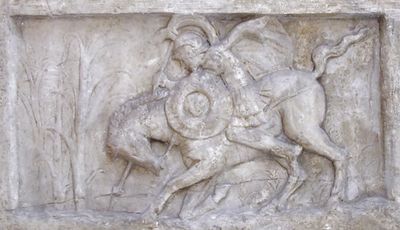
Cavalry spears
During this time the spear also was used by cavalry. The majority of ancient cavalry were equipped either with javelins or a one-handed thrusting spear similar to that used by infantry. Some, however, used longer spears. The Macedonian Xyston was 12–14 ft. (3.6–4.2 m) in length and could be used with one or two hands. The use of the two-handed Kontos (weapon) by heavily armored soldiers on horseback, known as Cataphracts, was developed first by nomadic eastern Iranian tribes and spread throughout the ancient world. These would be used to great effect by the Successor kingdoms and the Parthians and, later, by the Sassanians and Sarmatians. Later Roman and Byzantine armies also made use of these troops.
European Middle Ages
After the fall of the Roman Empire, the spear and shield continued to be used by almost all Western European cultures. Since a medieval spear required only a small amount of steel along the sharpened edges (most of the spear-tip was wrought iron), it was an economical weapon. Quick to manufacture, and needing less smithing skill than a sword, it remained the main weapon of the common soldier. The Vikings, for instance, although often portrayed with axe or sword in hand, were armed mostly with spears,[12] as were their Anglo-Saxon, Irish, or continental contemporaries.
Infantry Spears
Broadly speaking, spears either were designed to be kept in hand (thrusting spears), or to be thrown (throwing spears). Within this simple classification, there was a remarkable range of types. For example, M.J. Swanton identified thirty different spearhead categories and sub-categories in Early Saxon England. [13] Most medieval spearheads were, however, broadly speaking, leaf-shaped. Notable types of Early medieval spears include the Angon, a throwing spear with a long head similar to the Roman pilum, used by the Franks and Anglo-Saxons and the winged (or lugged) spear, which had two prominent wings at the base of the spearhead, either to prevent the spear penetrating too far into an enemy or to aid in spear fencing.[14] Originally a Frankish weapon, the winged spear also was popular with the Vikings.[15] It would become the ancestor of later medieval polearms, such as the partisan and spetum.
The thrusting spear also has the advantage of reach, being considerably longer than other weapon types. Exact spear lengths are hard to deduce as few spear shafts survive archaeologically but 6 ft. - 8 ft. (1.8m - 2.5m) would seem to have been the norm. Some nations were noted for their long spears, including the Scots and the Flemish. Spears usually were used in tightly ordered formations, such as the shieldwall or the schiltron. To resist cavalry, spear shafts could be planted against the ground. [16] William Wallace drew up his schiltrons in a circle at the Battle of Falkirk in 1298 to deter charging cavalry,[17] but it was a widespread tactic, sometimes known as the "crown" formation.[18]
Throwing spears became rarer as the Middle Ages drew on, but survived in the hands of specialists such as the Catalan Almogavars.[19] They were used commonly in Ireland until the end of the sixteenth century.[20]
Spears began to lose fashion among the infantry during the fourteenth century, being replaced by pole weapons that combined the thrusting properties of the spear with the cutting properties of the axe, such as the halberd. Where spears were retained they grew in length, eventually evolving into pikes, which would be a dominant infantry weapon in the sixteenth and seventeenth centuries.[21]
Cavalry Spears
Cavalry spears were originally the same as infantry spears and often were used with two hands or held with one hand overhead. In the eleventh century, after the adoption of stirrups and a high-cantled saddle, the spear became a decidedly more powerful weapon. A mounted knight would secure the lance by holding it with one hand and tucking it under the armpit (the couched lance. technique)[22] This allowed all the momentum of the horse and knight to be focused on the weapon's tip, whilst still retaining accuracy and control. This use of the spear spurred the development of the lance as a distinct weapon that was perfected in the medieval sport of jousting.
In the fourth century, tactical developments meant that knights and men-at-arms often fought on foot. This led to the practice of shortening the lance to about 5 ft. (1.5m.) to make it more manageable.[23] As dismounting became commonplace, specialist pole weapons such as the pollaxe were adopted by knights and this practice ceased.[24]
European Renaissance and After
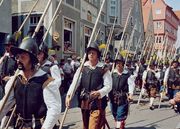
Infantry weapons
The development of both the long, two-handed pike and gunpowder in Renaissance Europe saw an ever increasing focus on integrated infantry tactics.[25] Those infantry not armed with these weapons, carried variations on the pole-arm, including the halberd and the bill. Ultimately, the spear proper was rendered obsolete on the battlefield. Its last flowering was the half-pike or spontoon,[26] a shortened version of the pike carried by officers and NCOs. While originally a weapon, this came to be seen more as a badge of office, or leading staff by which troops were directed.[27] The half-pike, sometimes known as a boarding pike, also was used as a weapon on board ships until the nineteenth century.[28]
Cavalry weapons
At the start of the Renaissance, cavalry remained predominantly lance armed; gendarmes with the heavy knightly lance and lighter cavalry with a variety of lighter lances. By the 1540s, however, pistol-armed cavalry called reiters were beginning to make their mark. Cavalry armed with pistols and other lighter firearms, along with a sword, virtually had replaced lance armed cavalry in Western Europe by the beginning of the seventeenth century,[29] although the lance persisted in Eastern Europe, from whence it was reintroduced into the European mainstream in the nineteenth century.
The Spear in East Asia
Warring States and early Sinitic Empires
Spears were used in Asia first as hunting weapons amongst the ancient Chinese and Koreans. They became popular as infantry weapons during the Warring States and Qin era, when spearmen were used as especially highly-disciplined soldiers in organized group attacks. When used in formation fighting, spearmen would line up their large rectangular or circular shields in a shieldwall manner. The Qin also employed long spearmen (more akin to a pike) in formations similar to Swiss pikemen in order to ward off cavalry. The Han Empire would use similar tactics as its Qin predecessors. Halberds, polearms, and dagger axes were also common weapons during this time.
Spears were also common weaponry for Warring States, Qin, and Han era cavalry units. During these eras, the spear would develop into a longer lance-like weapon used for cavalry charges.
Medieval Japan, Korea, etc
Medieval Japan employed spears for infantrymen to use, but it was not until the eleventh century in Japan that samurai began to use spears over bows. In Korea, spear infantry were used regularly by the Three Kingdoms of Korea armies. Koguryo and Shilla soldiers were well-trained and hardened by years of war. By fighting lifetimes of war, they discovered that heavily armored spear infantry was very effective in breaking apart thickly defended areas and charging cavalry units. The spear and pole arms were a favorite in the hwarang.
Halberd-like pole weapons were also common weapons amongst Asian armies. The most notable use of a pole weapon in Asia would be during the Imjin Wars, a war between the Koreans and the Japanese. Korean castle and fort defenders typically, were armed with the dangpa, a variation of a pole weapon called a trident. The dangpa was a favorite amongst the Korean vanguards because of its usefulness in siege combat, its striking power, and its piercing capabilities. It was particularly effective against Japanese samurai and ashigaru armor and was used, en masse, to corner multiple swordsmen. The dangpa was used by a few Korean marines in Admiral Yi's naval operations as "pushing" infantry, literally meaning to push back Japanese marines; the remainder of Korean marines carried swords to board Japanese ships, or bows and arrows to attack from a distance. Other Korean pole arms included the woldo, which resembled the Chinese Kwan Dao.
Several spears and pole weapons were very fearsome in the Japanese theatres; the naginata was a heavy, but powerful pole arm often used by mounted samurai in the sixteenth century. It was described as a sword attached to a spear and although it was unwieldy, skilled users could fight many opponents at once.
The Spear in Mesoamerica
As advanced metallurgy was largely unknown in pre-Columbian America, most weapons in Meso-America were made of wood or obsidian. This didn't mean that they were less lethal, as obsidian may be sharpened to become many times sharper than steel.[30] Meso-American spears varied greatly in shape and size. While the Aztecs preferred the sword-like macuahuitl for fighting,[31] the advantage of a far-reaching thrusting weapon was recognised, and a large portion of the army would carry the tepoztopilli into battle.[32] The tepoztopilli was a pole-arm, and to judge from depictions in various Aztec codices, it was roughly the height of a man, with a broad wooden head about twice the length of the users' palm or shorter, edged with razor-sharp obsidian blades which were deeply set in grooves carved into the head, and cemented in place with bitumen or plant resin as an adhesive. The tepoztopili was able both to thrust and slash effectively.
Throwing spears also were used extensively in Meso-American warfare, usually with the help of an atlatl.[33] Throwing spears were typically shorter and more stream-lined than the tepoztopilli, and some had obsidian edges for greater penetration.
The Spear in Africa
The Zulu people of eastern South Africa were known for their particular skill with shortened thrusting spears (called iklwa or assegai). These spears were designed for close combat and often, were wielded in conjunction with a large ovular shield. Advanced skills in close combat allowed the Zulu military to conquer much of south-east Africa.
Spear Hunting
Types of Hunting Spear
Barred spears
A barred spear has a crossbar beneath the blade, to prevent too deep a penetration of the spear into an animal. The bar may be forged as part of the spearhead or may be more loosely tied by means of loops below the blade. Barred spears are known from the Bronze Age, but the first historical record of their use in Europe is found in the writings of Xenophon in the fifth century BC.[34] Examples also are shown in Roman art. In the Middle Ages, a winged or lugged war-spear was developed (see above), but the later Middle Ages saw the development of specialised types, such as the boar-spear and the bear-spear.[35] The boar-spear could be used both on foot or horseback.
Javelin
Barbed Spears
Harpoon
Multi-bladed spears
Spear hunting in Africa
The spear was common in Africa, used mainly for hunting. For hunting, the spear was thrown at a wild beast while at the same time, purposely nicking the thrower's arm. If the spear killed the animal in one shot, the other arm would be nicked, thus representing the hunter's skill at throwing and capturing. Recently, there was a discovery of two human bodies in Benin, in which hot clay and earth preserved the skin and bones of the bodies, where a man had more than fifty nicks to the arms. He was found beside a pregnant woman.
Modern spear hunting
Spear hunting fell out of favour in most of Europe in the eighteenth century, but continued in Germany, enjoying a revival in the 1930s.[36] Spear hunting still is practiced in the USA,[37] notably by retired U.S. Air Force Colonel Gene Morris, NFL Defensive End Jared Allen, and "Motor City Madman" Ted Nugent.[38] Animals taken are primarily, wild boar and deer, although trophy animals such as cats and big game as large as a Cape Buffalo are hunted with spears. Alligator are hunted in Florida with a type of harpoon.
The Spear in Modern Martial Arts
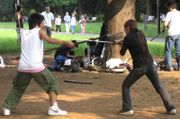
Spears, although apparently simple weapons, have a remarkable variety of wielding methods. Some are listed here from most passive to most active motions.
- Holding the spear or bracing it against the ground, a charging enemy impales themselves
- The spear is thrust out with the arms alone
- The spear is held stiffly, and the thrust is delivered by stepping forward
- The spear is thrust out with the arms while stepping forward with one or both feet
- The front hand releases as the back hand and back foot move forward to perform a long thrust
- The spear is slid through the front hand, propelled by the back hand (a similar action to using a Billiards Cue)
- The spear is thrown, often at a run, releasing when the opposite foot to the throwing arm is forward
- The spear is held couched under one arm, allowing a swinging motion as well as a powerful thrust
- The spear is swung rather than thrust, causing the tip of the blade to slice open the foe's flesh; the sheer momentum built up by swinging may be enough to cause serious injury even with the blunt end; the spear then may be brought around in a stabbing motion
The spear in myth and legend
Symbolism
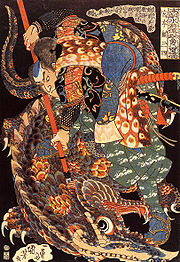
More than a weapon, a spear may be a symbol of power. In the Chinese martial arts community, the Chinese spear (Qiang 槍) is popularly known as the "king of weapons".
The Celts would symbolically destroy a dead warrior's spear to prevent its use by another.
In classical Greek mythology Zeus' bolts of lightning may be interpreted as a symbolic spear. Some would carry that interpretation to the spear that frequently is associated with Athena, interpreting her spear as a symbolic connection to some of Zeus' power beyond the Aegis once he rose to replacing other deities in the pantheon. Athena was depicted with a spear prior to that change in myths however. Chiron's wedding-gift to Peleus when he married the nymph Thetis in classical Greek mythology, was an ashen spear as the nature of ashwood with its straight grain made it an ideal choice of wood for a spear.
The Romans and their early enemies would force prisoners to walk underneath a 'yoke of spears', which humiliated them. The yoke would consist of three spears, two upright with a third tied between them at a height which made the prisoners stoop.[39] It has been surmised that this was because such a ritual involved the prisoners' warrior status being taken away. Alternatively, it has been suggested that the arrangement has a magical origin, a way to trap evil spirits.[40] The word subjugate has its origins in this practice (from Latin sub = under, jugum=a yoke).[4]
Odin's spear (named Gungnir) was made by the sons of Ivaldi. It had the special property that it never missed its mark. During the War with the Vanir, Odin symbolically threw Gungnir into the Vanir host. This practice of symbolically casting a spear into enemy ranks at the start of a fight sometimes was used in historic clashes, to seek Odin's support in the coming battle.[41] In Wagner's opera Siegfried, the haft of Gungnir is said to be from the "World-Tree" Yggdrasil.[42]
Other spears of religious significance are the Holy Lance[43] and the Lúin of Celtchar,[44] believed by some to have vast mystical powers.
Sir James George Frazer in The Golden Bough [45] noted the phallic nature of the spear and suggested that in the Arthurian Legends the spear or lance functioned as a symbol of male fertility, paired with the Grail (as a symbol of female fertility).
Tamil (Thamizh) people worship the spear as the weapon of the god Murugan. Murugan's spear is called the Vel. In Srilanka and India there is a dominant caste named Vellalar. The name vellalar is derived from vel + aalar, which means "ruler of the spear".
Legendary spears
- Holy Lance or Lance of Longinus, said to be the spear that pierced the side of Jesus
- Gungnir Spear of Odin, famous god in Norse mythology
- Amenonuhoko Spear of Izanagi and Izanami, creator gods in Japanese mythology
- Spear of Lugh or Spear of Lúin named after Lugh, a god in Irish mythology
- Gáe Bulg Spear of Cúchulainn, hero in Irish mythology
- Trishula Spear of Shiva, a Hindu god
- Octane Serpent Spear of Zhang Fei (Yide) from the Three Kingdoms period in China
- Spear of Fuchai, the spear used by Goujian's arch-rival, King Fuchai of Wu, in China
- Poseidon's Trident in Greek mythology the sea god's three-pronged spear was given to him by the undersea Cyclops, a parallel exists with the Roman god Neptune
Types of spears
Spears which are not usually thrown
|
|
|
Spears usually thrown
|
|
|
Notes and references
- ↑ Jill D. Pruetz1 and Paco Bertolani, Savanna Chimpanzees, Pan troglodytes verus, Hunt with Tools", Current Biology, March 6, 2007
- ↑ Orangutan attempts to hunt fish with spear, April 26, 2008
- ↑ Lower Palaeolithic hunting spears from Germany. Hartmut Thieme. Letters to Nature. Nature 385, 807 - 810 (27 February 1997); doi:10.1038/385807a0 [1]
- ↑ Rick Weiss, "Chimps Observed Making Their Own Weapons", The Washington Post, February 22, 2007
- ↑ Wymer, John (1982). The Palaeolithic Age. London: Croom Helm. p. 192. ISBN 070992710X.
- ↑ Webster, T.B.L. (1977). From Mycenae to Homer. London: Methuen. pp. 166–8. ISBN 0416705707. http://books.google.com/?id=jJgOAAAAQAAJ&pg=PA168&lpg=PA168&dq=spear+homer&q=spear%20homer. Retrieved 15 Feb 2010.
- ↑ Hanson, Victor Davis (1999). "Chapter 2 : The Rise of the City State and the Invention of Western Warfare". The Wars of the Ancient Greeks. London: Cassell. pp. 42–83. ISBN 0304359823.
- ↑ Hanson (1999), p. 59
- ↑ Hanson (1999), pp.147-8
- ↑ Hanson (1999), pp149-150
- ↑ Bishop, M.C.; Coulston J.C. (1989). Roman Military Equipment. Princes Risborough: Shire Publications. ISBN 0747800057.
- ↑ Viking Spears
- ↑ Swanton, M.J. (1973). The Spearheads of the Anglo-Saxon Settlement. London: Royal Archaeological Institute.
- ↑ Martin, Paul (1968). London: Herbert Jenkins. p. 226.
- ↑ Viking Spears, op.cit.
- ↑ e.g. at the Battle of Steppes 1213Oman, Sir Charles (1991 (originally 1924)). The Art of War in the Middle Ages. 1. London: Greenhill Books. p. 451. ISBN 1853671002.
- ↑ Fisher, Andrew (1986). William Wallace. Edinburgh: John Donald. p. 80. ISBN 0859761541.
- ↑ Verbruggen, J.F. (1997). The Art of Warfare in Western Europe in the Middle Ages (2nd. ed.). Woodbridge: Boydell Press. pp. 184–5. ISBN 0851156304.
- ↑ Morris, Paul (September 2000). ""We have met Devils!" : The Almogavars of James I and Peter III of Catalonia-Aragon". Anistoriton 004. http://www.anistor.gr/english/enback/v004.htm. Retrieved 2009-08-04.
- ↑ Heath, Ian (1993). The Irish Wars 1485-1603. Oxford: Osprey. p. 36. ISBN 9781855322806.
- ↑ Arnold, Thomas (2001). The Renaissance at War. London: Cassel & Co.. pp. 60–72. ISBN 0304352705.
- ↑ Nicholson, Helen (2004). Medieval Warfare. Basingstoke: Palgrave MacMillan. pp. 102–3. ISBN 0333763319.
- ↑ Nicholson (2004),p. 102
- ↑ Nicholson (2004), p101
- ↑ Arnold (2001), pp.66-72, 78-81
- ↑ Oakeshott, Ewart (1980). European Weapons and Armour. Guildford & London: Lutterworth Press. p. 56. ISBN 0718821262.
- ↑ Oakeshott (1980), p.55
- ↑ Oakeshott (1980), p.56
- ↑ Arnold (2001), pp.92-100
- ↑ >Buck, BA (March 1982). "Ancient technology in contemporary surgery". The Western journal of medicine 136 (3): 265–269. ISSN 0093-0415. OCLC 115633208. PMID 7046256.
- ↑ http://www.precolumbianweapons.com/warfare.htm
- ↑ http://www.precolumbianweapons.com/spears.htm
- ↑ http://www.precolumbianweapons.com/atlatl.htm
- ↑ Blackmore, Howard (2003). Hunting Weapons from the Middle Ages to the Twentieth Century. Dover. pp. 83–4. ISBN 0486409619. http://books.google.com/?id=XnnlOcLAnBIC&pg=PA90&lpg=PA90&dq=medieval+boar+spears&q=. Retrieved March 2010.
- ↑ Blackmore (2003), pp.88-91
- ↑ Blackmore (2003), pp92-3.
- ↑ Hunting With Spears
- ↑ Legal Status of Spear Hunting Challenged
- ↑ Connolly, Peter (1981). Greece and Rome at War. London: Macdonald Phoebus. p. 89. ISBN 035606798X.
- ↑ M. Cary and A. D. Nock : Magic Spears, The Classical Quarterly, Vol. 21, No. 3/4 (Jun. - Oct., 1927), pp. 122-127
- ↑ Crossley-Holland, Kevin (1982). The Norse Myths. London: Penguin. pp. 51,197. ISBN 0140060561.
- ↑ Siegfried, Act I, Scene 2
- ↑ "Lance, Holy" The Concise Oxford Dictionary of the Christian Church. Ed. E. A. Livingstone. Oxford University Press, 2006. Oxford Reference Online. Oxford University Press. [2]
- ↑ "Lúin" A Dictionary of Celtic Mythology. James McKillop. Oxford University Press, 1998. Oxford Reference Online. Oxford University Press. [3]
- ↑ Frazer, James G. : The Golden Bough, 1890
See also
- Arrow
- Atlatl
- Bayonet
- Dart
- Lance
- Migration period spear
- Pike (weapon)
- Pole weapon
- Qiang, Chinese spear
- Spearfishing
- Viking Age arms and armour
- Woomera
- Yari, Japanese spear
- Dangpa, Korean spear
External links
Historical
- SPEAR (O. Eng. spere, O. H. Ger. sper, mod. Ger. sp)
- Anglo-Saxon spear forging
- Ancient Weapons - Spears
- Viking Spears
- Irish Living History site
- Masai Spears
- The Vel in Sri lanka